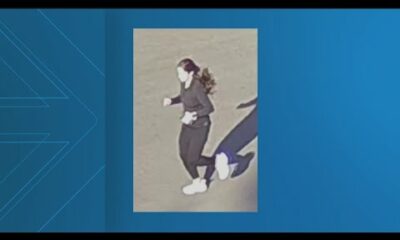Mississippi Today
When Biden stepped down, Kamala Harris called her pastor, a Mississippi native, for a prayer

The day President Joe Biden announced he would step aside and endorse Vice President Kamala Harris for the Democratic nomination, one of the first calls Harris made was to her longtime pastor, a native Mississippian and storied civil rights leader.
The Rev. Amos C. Brown, an 83-year-old Jackson native and pastor at San Francisco’s Third Baptist Church, is no stranger to such high-profile contacts. He has often been turned to by U.S. presidents. He was a close mentee of Medgar Evers. Martin Luther King Jr. tutored Brown at Morehouse College and even wrote Brown a letter of recommendation for seminary.
But Brown acknowledged in an interview with Mississippi Today that July 21 was extraordinarily memorable. He was just about to walk to the pulpit of the historic church to deliver his sermon when a deacon privately shared the news about Biden’s just-announced decision to drop out of the race.
“I paused to mention it to the congregation before I read the sermon text, which I selected well before I knew anything about what would happen that day,” Brown said. “That text was from Hebrews 12: ‘Therefore since we are surrounded by so great a cloud of witnesses, let us lay aside every weight, and the sin which so easily beset us, and let us run with endurance the race that is set before us, looking unto Jesus, the author and finisher of our faith.’ The timing of that text struck me as providential and poetic.”
After the Sunday service, Brown and his wife visited with members, went home, and, as pastors so often do on Sunday afternoons, he laid down to rest.
“I was actually about to go to sleep and my phone rang,” Brown said. “When I answered, it was the vice president’s voice. She said, ‘Hello, my pastor. I call because I need for you to pray for me, for Doug (Emhoff, her husband), for this nation because I’ve decided to run for president.’ I handed my phone to my wife, they talked for a minute, and then we had prayer together.”
Brown, invoking a cornerstone Christian verse from the Book of Micah, continued: “I prayed for her safety and security. I prayed she’d be led by spirituality as she sought the presidency, to do justice, love mercy, and walk humbly with her God. Then I recited a passage from James Weldon Johnson’s great hymn ‘Lift Every Voice and Sing.’”
Harris is a longtime member of Third Baptist Church — Brown called her “an old-timer” — and she has talked extensively about her upbringing in both the Christian and Hindu faiths. Harris wrote in her 2019 memoir that her “earliest memories of the teachings of the Bible were of a loving God, a God who asked us to ‘speak up for those who cannot speak for themselves’ and to ‘defend the rights of the poor and needy.’”
Her Baptist upbringing, in particular, centers on the teachings of Brown, a civil rights leader who has fought for those same virtues for nearly 70 years.
Brown’s civil rights work began in his hometown of Jackson, where he organized the first NAACP youth council at College Hill Baptist Church. At age 15, he rode with Medgar Evers from Jackson to San Francisco for the 1956 NAACP national convention, held at the same Third Baptist Church that he has now pastored for nearly 50 years. He was temporarily expelled from Jim Hill High School for talking with a national newspaper about the importance of integration, and he was later stripped of his earned class president and high school valedictorian status. The Mississippi Sovereignty Commission kept an extensive file on the teenager.
Later, after leaving Jackson for college at Morehouse in Atlanta, he traveled around the South to help lead the Movement, like organizing a wade-in at Tybee Island, Georgia, and serving as a leader for NAACP chapters in numerous states. While preaching at Third Baptist and at churches in St. Paul, Minnesota, and West Chester, Pennsylvania, he has been elected or appointed to numerous civil rights posts. He served as a delegate to the United Nations World Conference Against Racism in 2001, president of the San Francisco chapter of the NAACP, and vice chair of California’s Reparations Task Force.
“I think Vice President Harris was attracted to the history of this church, to the role we’ve played in social justice and advancing the human race,” Brown said. “She’s a strong, spiritual person who comes from a strong, spiritual family that we’ve known for a very long time now.”
The relationship between Brown and Harris transcends faith. Brown said Harris served as his campaign manager when he ran for reelection to the San Francisco Board of Supervisors in 1999, and he publicly supported her successful campaigns for San Francisco district attorney, California attorney general, U.S. Senate and vice president.
But the spiritual bond the two share, Brown said, is what he’s been dwelling on most these past few days as his friend and church member barrels toward the Democratic presidential nomination ahead of a pivotal November election.
“She’s above all else a good and decent human being,” Brown said. “If we had more people in this world of her integrity and her personhood, we’d get closer to being an expression of that beloved community that Dr. Martin Luther King envisioned. That’s the kind of outlook we need to hear in America today.
“All this division and put-down and hate speech and fear mongering is too much,” Brown continued. “There’s just too much of that. Someone once said people tend to hate each other because they fear each other. They fear each other because they don’t know each other. Well, they don’t know each other because they don’t communicate or connect with each other. We must connect with each other, and we must love each other. That’s the message Kamala Harris is going to share with the country because that’s who she is. That’s the person I’ve known for so long.”
As for his time in Mississippi, Brown said he’s been fortunate to carry his home state legacy with him around the world.
“Everybody has a connection to Mississippi. I think about Jackson often,” he said. “You know, the deacon who tapped me on the shoulder before I preached (on July 21) to tell me that President Biden had stepped down? That was Brother Cedric Carter, who’s actually from Vicksburg originally.”
This article first appeared on Mississippi Today and is republished here under a Creative Commons license.![]()
Mississippi Today
IHL deletes the word ‘diversity’ from its policies

The governing board of Mississippi’s public universities voted Thursday to delete the word “diversity” from several policies, including a requirement that the board evaluate university presidents on campus diversity outcomes.
Though the Legislature has not passed a bill targeting diversity, equity and inclusion initiatives in higher education, the Institutions of Higher Learning Board of Trustees approved the changes “in order to ensure continued compliance with state and federal law,” according to the board book.
The move comes on the heels of the re-election of former President Donald Trump and after several universities in Mississippi have renamed their diversity offices. Earlier this year, the IHL board approved changes to the University of Southern Mississippi’s mission and vision statements that removed the words “diverse” and “inclusiveness.”
In an email, John Sewell, IHL’s communications director, did not respond to several questions about the policy changes but wrote that the board’s goal was to “reinforce our commitment to ensuring students have access to the best education possible, supported by world-class faculty and staff.”
“The end goal is to support all students, and to make sure they graduate fully prepared to enter the workforce, hopefully in Mississippi,” Sewell added.
On Thursday, trustees approved the changes without discussion after a first reading by Harold Pizzetta, the associate commissioner for legal affairs and risk management. But Sewell wrote in an email that the board discussed the policy amendments in open session two months ago during its retreat in Meridian, more than an hour away from the board’s normal meeting location in Jackson.
IHL often uses these retreats, which unlike its regular board meetings aren’t livestreamed and are rarely attended by members of the public outside of the occasional reporter, to discuss potentially controversial policy changes.
Last year, the board had a spirited discussion about a policy change that would have increased its oversight of off-campus programs during its retreat at the White House Hotel in Biloxi. In 2022, during a retreat that also took place in Meridian, trustees discussed changing the board’s tenure policies. At both retreats, a Mississippi Today reporter was the only member of the public to witness the discussions.
The changes to IHL’s diversity policy echo a shift, particularly at colleges and universities in conservative states, from concepts like diversity in favor of “access” and “opportunity.” In higher education, the term “diversity, equity and inclusion” has traditionally referred to a range of efforts to comply with civil rights laws and foster a sense of on-campus belonging among minority populations.
But in recent years, conservative politicians have contended that DEI programs are wasteful spending and racist. A bill to ban state funding for DEI in Mississippi died earlier this year, but at least 10 other states have passed laws seeking to end or restrict such initiatives at state agencies, including publicly funded universities, according to ABC News.
In Mississippi, the word “diversity” first appeared in IHL’s policies in 1998. The diversity statement was adopted in 2005 and amended in 2013.
The board’s vote on Thursday turned the diversity statement, which was deleted in its entirety, into a “statement on higher education access and success” according to the board book.
“One of the strengths of Mississippi is the diversity of its people,” the diversity statement read. “This diversity enriches higher education and contributes to the capacity that our students develop for living in a multicultural and interdependent world.”
Significantly, the diversity statement required the IHL board to evaluate the university presidents and the higher learning commissioner on diversity outcomes.
The statement also included system-wide goals — some of which it is unclear if the board has achieved — to increase the enrollment and graduation rates of minority students, employ more underrepresented faculty, staff and administrators, and increase the use of minority-owned contractors and vendors.
Sewell did not respond to questions about if IHL has met those goals or if the board will continue to evaluate presidents on diversity outcomes.
In the new policy, those requirements were replaced with two paragraphs about the importance of respectful dialogue on campus and access to higher education for all Mississippians.
“We encourage all members of the academic community to engage in respectful, meaningful discourse with the aim of promoting critical thinking in the pursuit of knowledge, a deeper understanding of the human condition, and the development of character,” the new policy reads. “All students should be supported in their educational journey through programming and services designed to have a positive effect on their individual academic performance, retention, and graduation.”
Also excised was a policy that listed common characteristics of universities in Mississippi, including “a commitment to ethnic and gender diversity,” among others. Another policy on institutional scholarships was also edited to remove a clause that required such programs to “promote diversity.”
“IHL is committed to higher education access and success among all populations to assist the state of Mississippi in meeting its enrollment and degree completion goals, as well as building a highly-skilled workforce,” the institutional scholarship policy now reads.
The board also approved a change that requires the universities to review their institutional mission statements on an annual basis.
A policy on “planning principles” will continue to include the word “diverse,” and a policy that states the presidential search advisory committees will “be representative in terms of diversity” was left unchanged.
This article first appeared on Mississippi Today and is republished here under a Creative Commons license.![]()
Mississippi Today
Closed St. Dominic’s mental health beds to reopen in December under new management

The shuttered St. Dominic’s mental health unit will reopen under the management of a for-profit, Texas-based company next month.
Oceans Behavioral Hospital Jackson, a 77-bed facility, will provide inpatient behavioral health services to adults and seniors and add intensive outpatient treatment services next year.
“Jackson continuously ranks as one of the cities for our company that shows one of the greatest needs in terms of behavioral health,” Oceans Healthcare CEO Stuart Archer told Mississippi Today at a ribbon cutting ceremony at its location on St. Dominic’s campus Thursday. “…There’s been an outcry for high quality care.”
St. Dominic’s 83-bed mental health unit closed suddenly in June 2023, citing “substantial financial challenges.”
Merit Health Central, which operates a 71-bed psychiatric health hospital unit in Jackson, sued Oceans in March, arguing that the new hospital violated the law by using a workaround to avoid a State Health Department requirement that the hospital spend at least 17% of its gross patient revenue on indigent and charity care.
Without a required threshold for this care, Merit Health Central will shoulder the burden of treating more non-paying patients, the hospital in South Jackson argued.
The suit, which also names St. Dominic’s Hospital and the Mississippi Department of Health as defendants, awaits a ruling from Hinds County Chancery Court Judge Tametrice Hodges-Linzey next year.
The complaint does not bar Oceans from moving forward with its plans to reopen, said Archer.

Oceans operates two other mental health facilities in Mississippi and over 30 other locations in Louisiana, Oklahoma and Texas.
“Oceans is very important to the Coast, to Tupelo, and it’s important right here in this building. It’s part of the state of Mississippi’s response to making sure people receive adequate mental health care in Mississippi,” said Lt. Governor Delbert Hosemann at the Nov. 21 ribbon cutting.
Some community leaders have been critical of the facility.
“Oceans plans to duplicate existing services available to insured patients while ignoring the underserved and indigent population in need,” wrote Hinds County Sheriff Tyree Jones in an Oct. 1 letter provided to Mississippi Today by Merit Health.
Massachusetts-based Webster Equity Partners, a private-equity firm with a number of investments in health care, bought Oceans in 2022. St. Dominic’s is owned by Louisiana-based Catholic nonprofit Franciscan Missionaries of Our Lady Health System.
Oceans first filed a “certificate of need” application to reopen the St. Dominic’s mental health unit in October 2023.
Mississippi’s certificate of need law requires medical facilities to receive approval from the state before opening a new health care center to demonstrate there is a need for its services.
The Department of Health approved the application under the condition that the hospital spend at least 17% of its patient revenue on free or low-cost medical care for low-income individuals – far more than the two percent it proposed.

Oceans projected in its application that the hospital’s profit would equal $2.6 million in its third year, and it would spend $341,103 on charity care.
Merit Health contested the conditional approval, arguing that because its mental health unit provides 22% charity care, Oceans providing less would have a “significant adverse effect” on Merit by diverting more patients without insurance or unable to pay for care to its beds.
Oceans and St. Dominic’s also opposed the state’s charity care condition, arguing that 17% was an unreasonable figure.
But before a public hearing could be held on the matter, Oceans and St. Dominic’s filed for a “change of ownership,” bypassing the certificate of need process entirely. The state approved the application 11 days later.
Merit Health Central then sued Oceans, St. Dominic and the State Department of Health, seeking to nullify the change of ownership.
“The (change of ownership) filing and DOH approval … are nothing more than an ‘end run’ around CON law,” wrote Merit Health in the complaint.
Oceans, St. Dominic’s and the Mississippi Department of Health have filed motions to dismiss the case.
This article first appeared on Mississippi Today and is republished here under a Creative Commons license.![]()
Mississippi Today
How Mississippi’s Supreme Court Runoff Election Could Impact Criminal Cases

Mississippi voters have dealt defeat to one conservative state Supreme Court justice and forced a moderate justice into a Nov. 26 runoff, with the final outcome possibly making the court more open to considering the rights of criminal defendants.
The nine-member court is largely conservative but justices have recently split in high-profile decisions that sharply affected state politics, including a ruling that shut down citizen-led ballot initiatives in Mississippi and allowed some state control over local criminal cases in its majority-Black capital. The court has also rendered rulings that have made the state increasingly unfavorable to defendants appealing their cases.
“The ability of death row inmates in particular, and inmates in general, to access the courts has been recently curtailed significantly,” Matthew Steffey, a professor at Mississippi College School of Law, told The Marshall Project – Jackson and Bolts following the Nov. 5 election.
Justice Dawn H. Beam joined the majority in those decisions, acquiring a reputation of being hostile to appeals by criminal defendants, and she ran for reelection this fall as the Republican Party’s favored candidate. However, she lost in the state’s 2nd District on Nov. 5 to David P. Sullivan, a defense attorney who has worked as a public defender.
Judicial races in Mississippi are nonpartisan and Sullivan has given few explicit signals about his judicial outlook. He has supported at least some criminal justice reforms and would be the third justice with experience as a defense attorney on this court. Some reformers nationwide have pushed for more professional diversity on the bench.
Even if Sullivan turns out to be more centrist or independent than Beam on criminal law, any overall shift in power on the court depends on the outcome of a runoff election next week.
Two-term Justice Jim Kitchens and challenger Jenifer B. Branning will face each other in the Nov. 26 runoff election after neither won more than 50% of the vote on Nov. 5. The runoff will take place across the 22 counties that make up the Supreme Court’s central district, including Hinds County, home to Jackson. Throughout the campaign, the state GOP targeted Kitchens with attacks, while Branning, a Republican state senator with a conservative voting record, is endorsed by the party.
Kitchens is one of two reliably moderate-to-liberal high court justices. Justices from among an additional group of four sometimes veer away from the majority, as well, but can be more unpredictable, and this group does not vote as a bloc.
Quinn Yeargain, a Michigan State University law professor who closely watches state courts, recently analyzed the court’s voting patterns and found Beam was consistently more conservative than Kitchens in recent cases. Yeargain told The Marshall Project – Jackson and Bolts that conservative and liberal voters often have few signals about how to select a candidate in judicial races. “It’s very hard to label the justices,” they said.
Sullivan — whose father was a Mississippi Supreme Court justice from 1984 to 2000 — called himself a “conservative” throughout his campaign. But he has also touted the value of judicial independence and criticized Beam for campaigning on her endorsement by the state Republican Party.
“I think that rubbed a lot of people the wrong way,” Sullivan told the Sun Herald newspaper, speaking of Beam’s use of the endorsement. “Judicial races are nonpartisan for a reason. A judge’s impartiality could be called into question.”
Sullivan has broad legal experience, but much of his career has focused on private criminal defense while also doing some public defense work. He told The Marshall Project – Jackson and Mississippi Today that he supported a new administrative rule handed down in 2023 by the state Supreme Court to require continuous legal representation for poor criminal defendants from the beginning of their cases. An investigation by The Marshall Project, ProPublica and the Northeast Mississippi Daily Journal last year found, however, that many courts were unready at the time to implement the new representation rules.
During the campaign, Sullivan told The Marshall Project – Jackson and Mississippi Today that more work is needed to improve public defense.
Kitchens has also advocated for public defense reforms during his two terms on the court. He told a committee of legislators last year that the “playing field is far from level” between prosecutors and poor defendants.
On other criminal justice issues, he has sometimes dissented from opinions upholding death sentences. His decisions have scrutinized prosecutorial conduct and inadequate legal representation.
Branning, the Republican senator, has a voting record on criminal justice issues that suggests a harsher approach toward criminal defendants. She has supported higher mandatory minimum sentences and reclassifying misdemeanors as felonies, has opposed expansion of parole and was among only a few lawmakers who voted against legalizing medical marijuana.
She also supported increasing the jurisdiction of a controversial, state-run police force inside the majority-Black city of Jackson as well as increasing state control over many felony cases in Jackson. The Supreme Court unanimously curtailed much state power over these felony cases, but a majority left some control intact, with Kitchens and another judge dissenting.
Branning did not respond to questions from The Marshall Project – Jackson and Mississippi Today during the Nov. 5 campaign about her possible judicial outlook.
Kitchens was a prosecutor and then in private practice before joining the bench. Branning is a practicing attorney who typically handles civil cases.
The winner of the Nov. 26 runoff will join Sullivan on a court that in recent years has been restricting the ability of people who say the legal system has wronged them to seek relief, legal experts told The Marshall Project – Jackson and Bolts this month.
Krissy Nobile, director of the state’s Office of Capital Post-Conviction Counsel, said it’s become “increasingly more difficult to correct a wrongful conviction.” Her office provides legal counsel for indigent people on death row.
She said a number of recent cases showed the barriers the high court has erected for criminal defendants appealing their convictions, and demonstrated indifference to civil rights violations. Kitchens disagreed with the majority, in full or in part, in all but one of the appeals, which the court unanimously denied.
In a case earlier this year, the Court ruled to monetarily fine an incarcerated person for filing any future post-conviction relief petitions that lacked merit. Kitchens joined a dissenting opinion condemning the fine. In another, the court denied a man who argued that his lawyers were ineffective and that they did not challenge prosecutorial misconduct or false forensic evidence presented by a medical examiner with a checkered past. The court’s majority denied the motion, and in the process, overturned a precedent that allowed ineffective counsel as an adequate reason to give a case another look in some types of appeals. Kitchens dissented, along with two other justices.
“For decades in Mississippi, the Court held that it would correct errors if there was a violation (of) a person’s fundamental rights,” Nobile said. But she added this has changed considerably. Now, if you land a terrible lawyer who rushes your case, “You are out of luck,” she said, “even if your core constitutional rights have been clearly violated.”
For the court’s majority, Nobile added, “The legal technicalities now trump a person’s constitutional rights.”

The runoff is the nation’s final supreme court race of the year. Thirty-two states held elections for their high courts earlier this year, resulting in a muddled picture, with liberals and conservatives each gaining ground in different places, Bolts reports.
Mississippi’s runoff outcome will heavily depend on turnout and the composition of the electorate. In the Supreme Court’s central district, voters split narrowly between Democrat Kamala Harris and Republican Donald Trump in the presidential election on Nov. 5, but the runoff is just two days before Thanksgiving and will likely see a large dropoff in turnout. Branning received 42% of the vote in the first round, and Kitchens received 36%, with three other candidates making up the rest.
There will also be a runoff the same day in the Gulf Coast area between Amy Lassiter St. Pé and Jennifer Schloegel for an open seat on the state Court of Appeals. The Court of Appeals hears both criminal and civil cases that have been appealed from lower courts. The Mississippi Supreme Court can hear cases directly on appeal or can assign cases to the Court of Appeals.
Observers agreed that against the national legal backdrop, neither a Kitchens victory nor a Branning victory would lead to a seismic change since neither outcome would flip the court’s conservative lean. Still, a modest shift could impact some of the most controversial cases, such as a rare 5-4 decision that upheld the death sentence in Willie Manning’s case.
A Kitchens win, coupled with Sullivan’s upset earlier this month, would deal the Republican Party rare setbacks in a state where it has been dominant and could put moderate forces in a position to grow their numbers further in future elections.
“You might end up with a normal conservative court,” law professor Yeargain said, “instead of one of the most conservative courts in the country.”
This article first appeared on Mississippi Today and is republished here under a Creative Commons license.![]()
-

 Our Mississippi Home7 days ago
Our Mississippi Home7 days agoCreate Art from Molten Metal: Southern Miss Sculpture to Host Annual Interactive Iron Pour
-

 Local News6 days ago
Local News6 days agoCelebrate the holidays in Ocean Springs with free, festive activities for the family
-

 News from the South - Georgia News Feed6 days ago
News from the South - Georgia News Feed6 days ago'Hunting for females' | First day of trial in Laken Riley murder reveals evidence not seen yet
-

 News from the South - Alabama News Feed7 days ago
News from the South - Alabama News Feed7 days agoFirst woman installed as commanding officer of NAS Pensacola
-

 Kaiser Health News4 days ago
Kaiser Health News4 days agoA Closely Watched Trial Over Idaho’s Near-Total Abortion Ban Continues Tuesday
-

 Mississippi Today6 days ago
Mississippi Today6 days agoOn this day in 1972
-

 News from the South - Alabama News Feed2 days ago
News from the South - Alabama News Feed2 days agoTrial underway for Sheila Agee, the mother accused in deadly Home Depot shooting
-

 News from the South - Georgia News Feed2 days ago
News from the South - Georgia News Feed2 days agoJose Ibarra found guilty in murder of Laken Riley | FOX 5 News


























